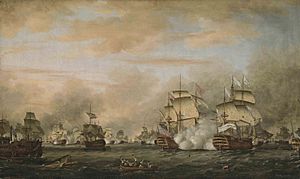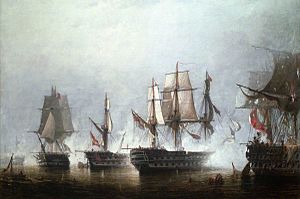James Nicoll Morris facts for kids
Quick facts for kids
Sir James Nicoll Morris
|
|
|---|---|
| Born | 1763 |
| Died | 15 April 1830 (aged 66) Marlow, Buckinghamshire |
| Allegiance | United Kingdom |
| Service/ |
Royal Navy |
| Years of service | 1772–1830 |
| Rank | Vice-Admiral of the Red |
| Commands held | HMS Flirt HMS Pluto HMS Boston HMS Lively HMS Phaeton Blackwater-Stour Sea Fencibles HMS Leopard HMS Colossus HMS Formidable |
| Battles/wars | American Revolutionary War |
| Awards | Knight Commander of the Order of the Bath Naval Gold Medal |
| Spouse(s) | Margaretta Sarah Somers Cocks |
Sir James Nicoll Morris (1763 – 15 April 1830) was a brave officer in the Royal Navy. He served during three major wars: the American Revolutionary War, the French Revolutionary Wars, and the Napoleonic Wars. He joined the navy in 1772. As a young officer, he fought in important battles like St Lucia, Grenada, and the Saintes.
Morris became a commander in 1790. He led ships like HMS Flirt and HMS Pluto. In 1793, he was promoted to post-captain and commanded HMS Boston. He was very good at capturing enemy ships. Later, he commanded HMS Lively, but it was wrecked in 1798. His next ship was HMS Phaeton, where he helped Austrian forces fight the French.
After a short break, Morris commanded HMS Leopard and then HMS Colossus in 1804. In October 1805, he fought bravely at the famous Battle of Trafalgar. His ship, Colossus, was heavily involved and suffered many injuries. Morris himself was hurt but kept fighting. He continued to serve until 1808. He then commanded HMS Formidable until he became a rear-admiral in 1811. He served in the Baltic Fleet until the Napoleonic Wars ended. This was his last service in the navy.
Contents
James Nicoll Morris was born in 1763. His father, John Morris, was also a captain in the Royal Navy. James joined the navy on January 19, 1772, when he was just nine years old. He started on HMS Otter, a 14-gun ship, which his father commanded.
He served on Otter in the Newfoundland area. Soon after, he moved to HMS Resolution, a larger 74-gun ship. He left the navy for a short time in 1775 to continue his schooling. Sadly, his father was badly wounded in a battle in 1776 and died. James was mentioned in his father's will as a "legacy to king and country."
Morris returned to the navy on March 31, 1778. He joined HMS Prince of Wales, a 74-gun ship, as a midshipman. This ship was the main ship for Rear-Admiral Samuel Barrington in the Leeward Islands. Morris then moved to HMS Ariadne in October. On this ship, he fought in the Battle of St. Lucia in December and the Battle of Grenada the next year.
He continued to move between ships, always serving under important admirals. In 1780, he became a lieutenant on HMS Queen. He later joined HMS Namur. On Namur, he helped relieve Gibraltar in 1781. Then, in 1782, he fought in the Battle of the Saintes in the Leeward Islands. As the American Revolutionary War ended, Morris left Namur in 1783 and went on half pay. He returned to active service in 1786 and served on several more ships. In 1790, he joined HMS Royal George during a tense time with Spain.
Leading Ships in Battle
Morris was promoted to commander on September 21, 1790. He took command of HMS Flirt in the Leeward Islands. He commanded her until late 1792. His next command was HMS Pluto, a 14-gun ship. In 1793, during the start of the French Revolutionary War, he captured a French privateer ship called Lutine.
Because of this success, Morris was promoted to post-captain on October 7, 1793. He was given command of HMS Boston, a 32-gun frigate. He sailed Boston back to England and then to the Mediterranean Sea. He was very successful off Cape Finisterre, capturing several Spanish privateer ships in 1797. In early 1798, he moved to command HMS Lively.
While off the Spanish coast, Lively was shipwrecked near Cadiz on April 12, 1798. It was a very dark night, and the ship got too close to shore. Other British ships rescued the crew. One crew member died from Spanish gunfire, but the rest were saved. Lively was then burned to prevent it from falling into enemy hands. Morris was not blamed for the loss of his ship.
On July 14, 1799, he received his next command: HMS Phaeton, a 38-gun frigate. In the autumn of 1799, Morris sailed Phaeton to Constantinople. He carried Lord Elgin, who was traveling to become an ambassador. After this, Phaeton stayed in the Mediterranean. In May 1800, Morris helped Austrian forces fighting the French in Italy. Phaeton fired on French troops as they retreated. Morris also captured twenty ships carrying supplies for the French army. In October, his ship's boats bravely captured a Spanish ship, San Josef, from under enemy guns. In 1801, Phaeton continued to serve off Spain. Morris sent his boats to capture another Spanish ship, L'Alcudia. He returned to England in early 1802 and left Phaeton.
The Battle of Trafalgar
Morris was not active during the Peace of Amiens. But when the Napoleonic Wars began in 1803, he was given command of local coastal defense forces called Sea Fencibles. In 1804, he took command of HMS Colossus, a 74-gun ship. When he first joined Colossus, her crew was not in good shape. But Morris worked hard to improve the ship and her crew. Colossus became known as an "excellent sailer."
In October 1805, Colossus joined Vice-Admiral Lord Nelson's fleet off Cadiz. On October 21, Morris and Colossus fought in the famous Battle of Trafalgar.
In the battle, Colossus was the sixth ship in the column led by Cuthbert Collingwood. As they approached the enemy, Morris ordered Colossus to fire her guns to create a smoke screen. This helped their advance. Colossus suffered the most damage and casualties of any British ship in the battle. Forty men were killed and 160 were wounded.
Colossus first fought the French ship Swiftsure. Her first broadside killed seventeen of Swiftsure's crew. Then, the French ship Argonaute crashed into Colossus's other side. Colossus was stuck between these two ships and took heavy fire for half an hour. Argonaute eventually pulled away after losing over 200 men. At one point, enemy sailors almost boarded Colossus, but her crew fought them off.
Morris continued to fight Swiftsure until it was badly damaged. Then, Colossus attacked the Spanish ship Bahama, which had been firing from a distance. Morris destroyed Bahama's mast, and the Spanish ship surrendered.
After this, Morris tried to move Colossus, but her main mast fell over. This meant Colossus's part in the battle was over. Morris himself was badly wounded in his leg. But he stayed on deck, even applying his own tourniquet. He only fainted from blood loss after the fighting ended. Colossus was towed to Gibraltar to be repaired. Morris recovered from his injury there.
Morris was given a Naval Gold Medal for his bravery at Trafalgar. He also received thanks from the Houses of Parliament. He continued to command Colossus after the battle. He served off Rochefort and then in the Mediterranean. He left the ship in 1808 due to a medical issue.
On April 1, 1810, he took command of HMS Formidable in the Baltic Fleet. On August 1, 1811, Morris was promoted to rear-admiral. He returned to the Baltic Fleet in 1812 as third-in-command, with HMS Vigo as his main ship.
In the Baltic, Morris protected convoys and defended against Danish attacks. He did not receive any more commands after the Napoleonic Wars ended in 1815. However, he was honored for his service and became a Knight Commander of the Order of the Bath on January 2. He continued to be promoted due to his long service, becoming a vice-admiral on August 12, 1819.
Sir James Nicoll Morris died at his home in Marlow, Buckinghamshire, on April 15, 1830, at the age of sixty-six. He is buried there.
Family Life
James Morris married Margaretta Sarah Somers Cocks on October 25, 1802. She was the daughter of a banker and the niece of Charles Cocks, 1st Baron Somers. Through this marriage, he became brother-in-law to Admiral Sir William Hargood.



